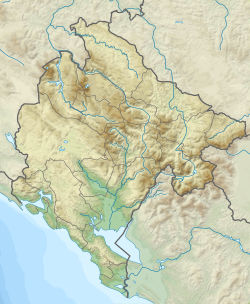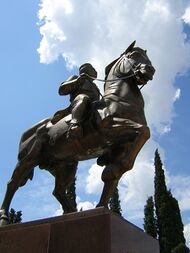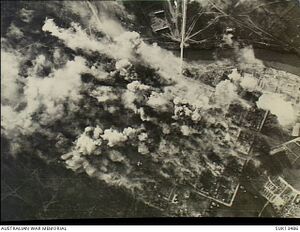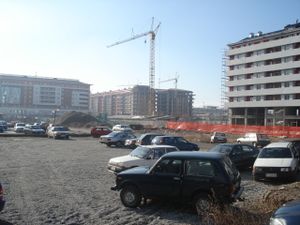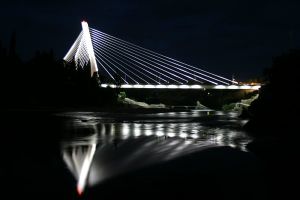بودغوريتسا
Podgorica
Подгорица | |
|---|---|
| |
Municipal Building Partisans Monument Petrović-Njegoš dynasty Royal Estate Business center Kruševac Independence square | |
|
| |
| الإحداثيات: 42°26′28.63″N 19°15′46.41″E / 42.4412861°N 19.2628917°E | |
| Country | |
| Municipality | |
| Founded | Before 11th century |
| الحكومة | |
| • النوع | Mayor-Assembly |
| • الكيان | City Assembly of Podgorica |
| • Mayor | Olivera Injac (PES!) |
| • Deputy Mayors | Danilo Šaranović (DCG) Luka Rakčević (URA) |
| • Assembly President | Jelena Borovinić Bojović (n-p; DF) |
| • Ruling coalition | PES!–DF/PCG–DCG/ UCG/Demos–URA/Civis |
| المساحة | |
| • Capital city | 108 كم² (42 ميل²) |
| • العمران | 1٬441 كم² (556 ميل²) |
| المنسوب | 40 m (130 ft) |
| التعداد (2011)[1] | |
| • الترتيب | 1st in Montenegro |
| • Urban | ▲ 150٬977 |
| • الريف | ▲ 34٬938 |
| • Metro | ▲ 185٬915 |
| صفة المواطن | Podgorician (Podgoričanin) (male) (Podgoričanka) (female) |
| منطقة التوقيت | UTC+01:00 (CET) |
| Postal code | 81 000 – 81 124 |
| مفتاح الهاتف | +382 20 |
| License plate | PG |
| الموقع الإلكتروني | podgorica |
پودگوريتسا (إنگليزية: Podgorica، بالمونتنگرية: Подгорица, پودگوريتسا أصد: [ˈpɔdgɔˌriʦa]) هي عاصمة وأكبر مدن الجبل الأسود. واحداثياتها هي 42°28′12″N 19°16′48″E / 42.47000°N 19.28000°E, 44 متر (144 ft) فوق سطح البحر.
حسب احصاء عام 2003، تعداد السكان 136،473 ؛ حوالي 22 ٪ من سكان هذه الجمهوريه. الموقع الجغرافي الاستراتيجي لپودگوريتسا عند ملتقي نهري ريبنيتسا و موراتشا، جعل المدينة جذابة.
تقع المدينه سوي بضعه كيلومترات من مراكز التزلج الشتوية في الشمال والجنوب علي البحر الأدرياتيكي كما في متناولهم. ولموقع المدينة اثر كبير في التطور السريع. الاسم يعني حرفيا "تحت جوريكا" باللغة الصربية. غوريكا (تعني "تذكر الجبال" هو اسم احد الجبال التي تشرف علي البلدة. المدينة عرفت باسم لدوكليا قبل العصر الروماني وروما. وفي العصور الوسطى، عرفت المدينة باسم ريبنيكا ، وبين 1945 و 1992 كانت تدعى تيتوگراد. وفي پودگوريتسا توجد عده مسارح ومكتبات وجامعات.
أصل الاسم
Podgorica is written in Cyrillic as Подгорица, تـُنطق [pǒdɡoritsa]; UK: /ˈpɒdɡɒrɪtsə, pɒdˈɡɔːr-/,[2] US: /ˈpɒdɡəriːtsə, ˈpɔːdɡɒr-/;[3][4][5] Podgorica literally means "under the hill". Gorica (بالسيريلية: Горица), a diminutive of the word Gora (Cyrillic: Гора) which is another word for Mountain or Hill, means "little/small hill", is the name of one of the cypress-covered hillocks that overlooks the city center. Some three kilometres (1.9 ميل) north-west of Podgorica lie the ruins of the Roman-era town of Doclea, from which the Roman Emperor Diocletian's mother hailed. In later centuries, Romans "corrected" the name to Dioclea, guessing wrongly that an i had been lost in vulgar speech. Duklja is the later South Slavic version of same word. At its foundation (some time before the 11th century), the town was called Birziminium. In the Middle Ages, it was known as Ribnica (بالسيريلية: Рибница, [rîbnitsa]). The name Podgorica was used from 1326. From 1946 to 1992, the city was named Titograd (بالسيريلية: Титоград, [tîtoɡraːd]) in honour of Josip Broz Tito, the President of Socialist Federal Republic of Yugoslavia from 1953 to 1980. In 1992 the city changed its name to "Podgorica", which it remains today.
التاريخ
التاريخ المبكر
Podgorica is at the crossroads of several historically important routes, near the rivers Zeta, Morača, Cijevna, Ribnica, Sitnica and Mareza in the valley of Lake Skadar and near the Adriatic Sea, in fertile lowlands with favourable climate. The earliest human settlements were in prehistory: the oldest physical remains are from the late Stone Age.
In the Iron Age, the area between the Zeta and Bjelopavlići valleys was occupied by two Illyrian tribes, the Labeates and the Docleatae. The population of the town of Doclea was 8,000–10,000, in which all core urban issues were resolved. The high population density (in an area of about 10 km (6 mi) radius) was made possible by the geographical position, favorable climate, and economic conditions and by the defensive positions that were of great importance at that time.
Middle Ages
From the fifth century AD, with the arrival of the first Slavic and Avar tribes and the beginning of the break-up of the Roman Empire, the area bore witness to many noteworthy events.[بحاجة لمصدر] With time, the fortifications ceased their function, and new towns were built; a new settlement probably named after the Ribnica river, on whose banks it was built, Ribnica, was established. It was first mentioned during the reign of the Nemanjić dynasty, as part of the Serbian kingdom. The importance of Ribnica was its position as crossroads in communications with the west.[بحاجة لمصدر]
The name Podgorica was first mentioned in 1326 in a court document of the Kotor archives. The city was economically strong: trade routes between the Republic of Ragusa and Serbia, well developed at that time, were maintained via the road that led to Podgorica through Trebinje and Nikšić. As a busy crossroads, Podgorica was a vibrant regional center of trade and communication. This boosted its development, economic power, military strength, and strategic importance.[بحاجة لمصدر]
Ottoman Empire

The Ottoman Empire captured Podgorica in 1474. Podgorica became a kaza of the Sanjak of Scutari (which was historically led by Albanian Pashas). In 1479, The Ottomans built a large fortress in Podgorica, and the existing settlement, with its highly developed merchant connections, became the main Ottoman defensive and attacking bastion in the region. At the beginning of 1474 the Ottoman sultan intended to rebuild Podgorica and Baleč and settle them with 5,000 Muslim families (most of them of Albanian or Slavic origin),[6] in order to stop cooperation between the Principality of Zeta and Albania Veneta.[7]
Podgorica fell again, but this time to the Ottomans in 1484, and the character of the town changed extensively. The Ottomans fortified the city, building towers, gates, and defensive ramparts that give Podgorica the appearance of an Ottoman military city.
Most of today's Montenegro and Podgorica fell under the rule of the Albanian Bushati Family of Shkodra between 1760 and 1831, which ruled independently from the Imperial authority of the Ottoman Sultan.
In 1864, Podgorica became a kaze of the Scutari Vilayet called Böğürtlen ("blackberry", also known as Burguriçe).
On 7 October 1874, in a violent reaction over the murder of a local named Juso Mučin Krnić,[8] Ottoman forces killed at least 15 people in Podgorica.[9] The massacre was widely reported outside of Montenegro and ultimately contributed to the buildup to the Montenegrin-Ottoman War.
The end of the Montenegrin-Ottoman War in 1878 resulted in the Congress of Berlin recognizing vast territories, including that of Podgorica, as part of the newly recognized Kingdom of Montenegro. At that time there were about 1,500 houses in Podgorica, with more than 8,000 people living there – of Orthodox, Roman Catholic, and Muslim faiths flourishing together.
The Petrović and Karađorđević monarchies
After the Berlin Congress in 1878, when Podgorica was annexed to the Principality of Montenegro, marking the end of four centuries of Ottoman rule, and the beginning of a new era for Podgorica and Montenegro. The first forms of capital concentration were seen in 1902 when roads were built to all neighboring towns, and tobacco became Podgorica's first significant commercial product. Then in 1904, a savings bank named Zetska formed the first significant financial institution, and it would soon grow into Podgorička Bank.
World War I marked the end of dynamic development for Podgorica, which by then was the largest city in the newly proclaimed Kingdom of Montenegro. On 10 August 1914, nine military personnel and 13 civilians were killed in Podgorica from an aerial bombardment by Austro-Hungarian Aviation Troops.[10] The city was bombed three more times in 1915.[10] Podgorica was occupied, as was the rest of the country, by Austria-Hungary from 1916 to 1918.
After the liberation by the Allies in 1918, the controversial Podgorica Assembly marked the end of Montenegrin statehood, as Montenegro was merged with the Kingdom of Serbia and incorporated into the Kingdom of Serbs, Croats, and Slovenes. The population of urban Podgorica during this interwar period was approximately 14,000.[11]
During the interwar period (1918–1941), Podgorica had public bathrooms as most residents did not have their own.[11] However, the Imperial hotel built in 1925 had two bathrooms, which was unprecedented at the time.[11] It was one of at least six hotels built in the city during the interwar period.[11]
World War II
After the Yugoslav coup d'état on 27 March 1941, demonstrations supporting the coup took place in Podgorica.[12] As a result of the coup, Yugoslavia turned against its previous alliance with the Axis powers and was subsequently invaded. Podgorica was bombed over 80 times throughout the course of the war.[13] The city was first bombed by the Luftwaffe on 6 April 1941. On 5 May 1944, Podgorica was bombed by the USAAF in an attack against Axis forces, although the bombardment that day killed approximately 400 civilians.[14] The city was liberated on 19 December 1944. According to the Museum of Genocide Victims, a total of 1,691 people were killed in Podgorica over the course of the war.[15]
Socialist Yugoslavia
On 12 July 1946, Josip Broz Tito made one of his early visits to Podgorica from the Radovče hotel, where he spoke to a crowd.[16] It was the first of fifteen total visits made by Tito to the city after World War II.[16]
"Podgorica is destroyed. We will build her altogether because it's our responsibility, because that's what's required of us by the sacrifices which Podgorica gave! We will do it, that's what I promise you in the name of the Federal government." -Josip Broz Tito on 12 July 1946.[16]
On 25 July 1948, the vice president of the People's Parliament of Montenegro, Andrija Mugoša, along with secretary Gavron Cemović, signed a law changing the name of Podgorica into "Titovgrad".[13] The law was "retroactively" activated such that the name change applied to any records starting from 13 July 1946, when it became the capital of Montenegro within the newly formed Socialist Federal Republic of Yugoslavia.[13] However, in a glaring contradiction, the "Službeni list" or legal code of Yugoslavia recorded the name "Titograd" without the letter "v".[13] Ultimately, "Titograd" was used over "Titovgrad".[13]
In addition to the new name, Titograd saw the establishment of new factories. The Radoje Dakić factory, built-in 1946 for the production of heavy machinery, became one of the largest employers in Titograd. In 1964, Radoje Dakić guaranteed hired workers an apartment in the city.[17] In the late 1960s, the cities of Titograd, Zadar, and Mostar competed to be selected as the location of Yugoslavia's expanding aluminum industry.[18] In a highly politicized selection process, Titograd was ultimately chosen and the Kombinat was constructed in 1969.[18] In 1974, the public Veljko Vlahović University was founded in Titograd. On 15 April 1979, the city suffered damage by a 6.9 magnitude earthquake.
Titograd was the site of massive protests during Yugoslavia's anti-bureaucratic revolution. On 10 January 1989, over 10,000 people protested in the city.[19][20] By the turn of the decade, Titograd was recognized as the city with the most greenery in Yugoslavia, along with Banja Luka.[21]
Contemporary history
As Yugoslavia began to break up, Titograd was renamed to Podgorica after a referendum on 2 April 1992.[22] On 25 May 1992, Podgorica was the site of a Serbian Radical Party rally of approximately 10,000 supporters, during which a Montenegrin Bosniak man named Adem Šabotić attempted to assassinate Vojislav Šešelj via hand bomb after his supporters chanted references to killing Muslims.[23] Šešelj, his bodyguards, and a few bystanders were injured after the bomb detonated but no one was killed.[23]
Otherwise, the Yugoslav wars largely bypassed Podgorica, but the entire country was greatly affected with severe economic stagnation and hyperinflation lasting throughout the 1990s due to international sanctions. In 1999, Podgorica was subject to airstrikes during the NATO bombing of Yugoslavia.[24][25]
On 13 July 2005, the newly constructed Millennium Bridge opened for traffic.[26] Following the results of the independence referendum in May 2006, Podgorica saw significant development as the capital of an independent state, including the reconstruction and renaming of the former Ivan Milutinović Square to Independence Square.
On 13 October 2008, at least 10,000 people protested against Kosovo's declaration of independence.[27] On 19 December 2008, the Moscow Bridge opened for pedestrians.
On 7 August 2013, the 60-year old Hotel Crna Gora was demolished to make way for the new Hilton in its place, which opened in 2016.[28] Construction of the Cathedral of Christ's Resurrection finished after 20 years on 7 October 2013.
In October 2015, protests took place in Podgorica ahead of Montenegro's accession into NATO. After a demonstration of at least 5,000 to 8,000 people,[29] the police used tear gas to disperse demonstrators from the parliament.[30] Protests in the city continued through the 2016 Montenegrin parliamentary election. On 22 February 2018, a Yugoslav Army veteran killed himself at the US embassy in Podgorica.
السكان
تعداد پودگوريتسا (المدينة)
| إحصاء | التعداد |
|---|---|
| 1948 | 14,369 |
| 1953 | 19,868 |
| 1961 | 35,054 |
| 1971 | 61,727 |
| 1981 | 96,074 |
| 1991 | 117,875 |
| 2003 | 136,473 |
'تعداد پودگوريتسا (البلدية)
| الإحصاء | التعداد |
|---|---|
| 1948 | 48,599 |
| 1953 | 55,669 |
| 1961 | 72,319 |
| 1971 | 98,796 |
| 1981 | 132,290 |
| 1991 | 179,401 |
| 2003 | 169,132 |
الأعراق في 2003 (البلدية)
| العرق | التعداد | النسبة |
|---|---|---|
| Montenegrins | 96,343 | 56.96% |
| صرب | 44,423 | 26.26% |
| ألبان | 19,341 | 11.42% |
| مسلمون | 4,399 | 2.60% |
| بوشناق | 2,307 | 1.36% |
| غجر | 1,389 | 0.82% |
| كروات | 709 | 0.42% |
الاقتصاد
الجغرافيا
| پودگوريتسا | ||||||||||||||||||||||||||||||||||||||||||||||||||||||||||||
|---|---|---|---|---|---|---|---|---|---|---|---|---|---|---|---|---|---|---|---|---|---|---|---|---|---|---|---|---|---|---|---|---|---|---|---|---|---|---|---|---|---|---|---|---|---|---|---|---|---|---|---|---|---|---|---|---|---|---|---|---|
| جدول طقس (التفسير) | ||||||||||||||||||||||||||||||||||||||||||||||||||||||||||||
| ||||||||||||||||||||||||||||||||||||||||||||||||||||||||||||
| ||||||||||||||||||||||||||||||||||||||||||||||||||||||||||||
العمارة
الرياضة
المنشآت الرياضية
المدن الشقيقة
انظر أيضاً
وصلات خارجية
- Podgorica official website
- Tourism Organisation of Podgorica
- Podgorica live cam
- Visit-Montenegro.com
- Photo-Montenegro.com
- National Tourism Organization of Montenegro
- Podgorica - WikiTravel
42°26′21″N 19°15′58″E / 42.4392°N 19.266°E{{#coordinates:}}: لا يمكن أن يكون هناك أكثر من وسم أساسي واحد لكل صفحة
- ^ "Montenegrin 2011 census". Monstat. 2011. Archived from the original on 9 December 2021. Retrieved 15 January 2012.
- ^ Wells, John C. (23 May 2008). Longman Pronunciation Dictionary. Pearson Longman. ISBN 978-1-4058-8118-0.
- ^ "Podgorica" (US) and "Podgorica". Lexico UK English Dictionary. Oxford University Press. Archived from the original on 2020-03-22.
- ^ "Podgorica". The American Heritage Dictionary of the English Language (5th ed.). HarperCollins. Retrieved 11 May 2019.
- ^ "Podgorica". Collins English Dictionary. HarperCollins. Archived from the original on 11 May 2019. Retrieved 11 May 2019.
- ^ Božić, Ivan (1979). "Nemirno pomorje XV veka" (in الصربية). Beograd: Srpska književna zadruga. p. 295. OCLC 5845972. Archived from the original on 10 April 2022. Retrieved 19 November 2020.
почетком 1474 ... о султановој намери да обнови Подгорицу и да је насели са пет хиљада турских домаћинстава, а исто тако да подигне из рушевина стари град Балеч
- ^ Ćorović, Vladimir (2005). Istorija Srba (in الصربية). Zoograf. p. 357. ISBN 9788675781271. Archived from the original on 10 April 2022. Retrieved 21 January 2012.
...очвидно из разлога да спрече везе између Зећана и Албанаца
- ^ Marijan-Mašo Miljić. "JUSOVAČA – KAZNENI ZAVOD U PODGORICI (1893–1945)" (in الصربية). Archived from the original on 11 January 2019. Retrieved 5 January 2019.
- ^ Perivoje Popović (7 November 2016). "Изблиза о далеком: Подгорички покољ 1874". ИН4С (in الصربية). Archived from the original on 6 January 2019. Retrieved 5 January 2019.
- ^ أ ب Veliša Kadić (7 April 2013). "Podgorica: Pustoš ostaje ispod bombi". Večernje novosti (in الصربية). Archived from the original on 22 September 2019. Retrieved 22 September 2019.
- ^ أ ب ت ث ""Imperijal" bio najljepši". Privredna komora Crne Gore (in الصربية). 5 August 2013. Archived from the original on 6 August 2020. Retrieved 9 June 2019.
- ^ Morrison 2009, p. 51.
- ^ أ ب ت ث ج Boban Novović. "Glavni grad je 47 godina nosio pogrešno ime: Kako je Titovgrad postao Titograd?". Vijesti (in الصربية). Archived from the original (via Wayback Machine) on 6 October 2018.
- ^ Kovačević, Branislav. Savezničko bombardovanje Crne Gore 1943. – 1944. godine. Svjedočanstvo. Podgorica, 2003. (pg. 57)
- ^ "Stradanje stanovništva Crne Gore u Drugom svetskom ratu". Макроекономија. 3 September 2016. Archived from the original on 22 September 2019. Retrieved 22 September 2019.
- ^ أ ب ت Slobodan Vuković. "Dolazi Tito". Vijesti (in الصربية). Archived from the original (via Wayback Machine) on 2 March 2016.
- ^ "Pogledajte Kako Je Izgledao Ugovor O Radu '60-Ih U Fabrici "Radoje Dakić"" (in الصربية). 8 May 2018. Archived from the original on 12 July 2018. Retrieved 16 March 2019.
- ^ أ ب Branko Kostić. "POČECI KOMBINATA ALUMINIJUMA". Montenegrina (in الصربية). Archived from the original on 14 March 2019. Retrieved 11 March 2019.
- ^ Milosavljević 2003.
- ^ Milan Milošević, Filip Švarm (1994-08-29). "Serbian President: The Technology of a Showdown". Vreme. Archived from the original on 9 May 2008. Retrieved 16 March 2019.
- ^ Predrag Nikolić (14 September 2018). "INICIJATIVA 100.000 STABALA ZA PODGORICU: Kome smeta drveće". Monitor (in الصربية). Archived from the original on 6 January 2019. Retrieved 5 January 2019.
- ^ Željko Vukmirović (17 August 2016). "Živjeti i umrijeti u Titogradu". Portal Analitika (in الصربية). Archived from the original on 1 February 2019. Retrieved 31 January 2019.
- ^ أ ب Avdo Huseinović (31 January 2021). "Sudbina atentatora na Šešelja: Znate li priču o Ademu Šabotiću?". BH MAGAZINE (in Bosnian). Archived from the original on 19 December 2021. Retrieved 19 December 2021.
{{cite web}}: CS1 maint: unrecognized language (link) - ^ MONTENEGRO: NATO BOMBING ATTACKS LATEST (YouTube). Associated Press. 29 April 1999. Archived from the original on 25 April 2020. Retrieved 16 March 2019.
- ^ William Booth (3 May 1999). "NATO Bombs Hit Montenegro Homes". The Washington Post. p. A31. Retrieved 16 March 2019.
- ^ "Na Dan državnosti Crne Gore otvoreni novi Most Milenijum i Tunel Sozina". eKapija (in Serbian). 14 July 2005. Archived from the original on 12 September 2022. Retrieved 6 January 2022.
{{cite news}}: CS1 maint: unrecognized language (link) - ^ "Neredi u Podgorici zbog Kosova" (in الصربية). Deutsche Welle. 14 October 2008. Archived from the original on 12 September 2022. Retrieved 16 March 2019.
- ^ "Zvanično otvoren prvi Hotel Hilton u Podgorici". Kodex. 20 September 2016. Archived from the original on 12 September 2022. Retrieved 6 January 2022.
- ^ Nemanja Rujević (15 November 2015). "Crna Gora: Protesti i ništa" (in الصربية). Deutsche Welle. Archived from the original on 6 August 2020. Retrieved 16 March 2019.
- ^ "Situacija u gradu se smirila" (in الصربية). Vijesti. 25 October 2015. Retrieved 16 March 2019.
- Pages using gadget WikiMiniAtlas
- صفحات ذات وسوم إحداثيات غير صحيحة
- Short description is different from Wikidata
- Articles containing مونتنجرية-language text
- Articles containing صربو-كرواتية-language text
- Pages using multiple image with auto scaled images
- Coordinates on Wikidata
- صفحات تستخدم جدول مستوطنة بقائمة محتملة لصفات المواطن
- Articles containing إنگليزية-language text
- Pages using Lang-xx templates
- Articles containing لاتينية-language text
- Articles with text in South Slavic languages
- Articles with unsourced statements from March 2017
- Articles with unsourced statements from June 2017
- Podgorica
- Cities, towns and villages in Montenegro
- الجبل الأسود
- عواصم أوروبا
- CS1 الصربية-language sources (sr)










